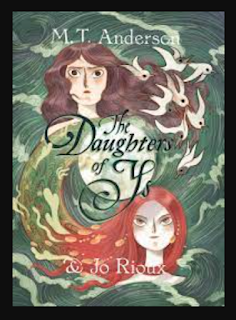Anderson, M. Daughters of Ys, (2020). New York, NY: First Second.
13-17 years according to Amazon
I love M. T. Anderson! We have been friends for over 20 years. Okay, Facebook friends, but he would know me in real life! I have slept over at his house - hell yeah, I’m going to drop that name! He is in the pantheon of talented YA writers and has such a breadth of topics that he is incomparable. Feed was a game changer for YA. His National award winning Astonishing Life of Octavian Nothing, Traitor to the Nation, Volume I: The Pox Party is a masterwork. Heck, even his deceptively light Landscape with Invisible Hand was made into a film that premiered at Sundance this year.
That being said, I didn’t love Daughers of Ys.
It is beautiful to look at. Jo Rioux has so much movement in her drawing, and her color palette is perfect for showing the differences in the sisters. And the story is interesting and beautifully written. A review from NPR made a connection that I just loved - “Rioux also borrows the glowing lights and velvety shadows of Maxfield Parrish's work for certain scenes, including a wonderful interlude set inside a circle of standing stones.” (Lehoczky, 2020) It’s a feast for the eyes. I think it was just too murdery for me.
The idea of two sisters, a dead mother, a father who is weak but plays strong - it has a lot going for it and according to Lehoczky, the original Breton tale is far more misogynistic. But I feel like Rozenn is too good to be true and Dahut is slut-shamed (and I guess murder-shamed) for things that are outside of her control.
As I think back, I read this a few weeks ago when I had a bad cold and perhaps it wasn’t the right book at the right time. And flipping through the pages, I am practically reading it again with a much more enchanted eye. Perhaps I have erred and I do like it after all!
From a school library perspective, it makes me sad that the bare cartoon bums would be much more of a content problem than, you know, the murders, but that is the world we live in. Still, and art class could definitely benefit from looking at Rioux’s work and an ELA class could discuss this more feminist retelling of an old folktale.
Lehoczky, E. (August 16, 2020) Feeling Deluged By News? Let 'The Daughters Of Ys' Wash Over You. NPR.





